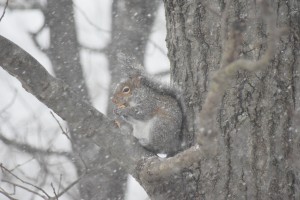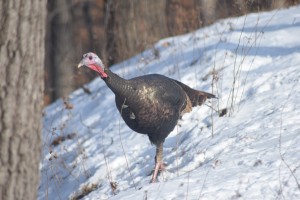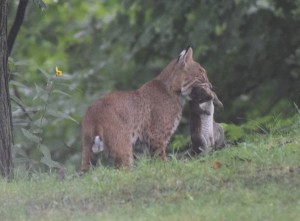Winter Is Fast Approaching, and the Critters Are Well Underway In Their Preparation
The days are getting shorter and the temperature is turning colder. It is time to do all those fall projects to ready our homes and yards for winter. Rake the leaves that seem to hang on to the trees forever, especially if your yard is full of oaks. Clean up the garden, pulling up the dying tomatoes and various other plants that produced all those wonderful fresh vegetables we enjoyed all summer. Cut off the dried and dying foliage from the summer annuals and cleanse the potted plants to bring in before the frost. Wrap up the hoses to keep them from freezing and scrub the tools so they don’t rust. Pull out those winter clothes and shoes even though you are not really ready to put them on. It seems like the list goes on forever.
Just like us, Mother Nature is also preparing for the winter months. Squirrels prepare for winter by doing two main things: stocking up on food and hiding it in various places. This is called scatter hoarding and they eat as much as they can, putting on a nice fatty layer between their fur and muscles thus providing insulation and a starter reserve of food for the winter. The gray squirrel (Sciurus carolinensis), for instance, has a penchant for burying acorns for later use. A single gray squirrel can create several thousand buried caches of food each season, not all of which it can hope to rediscover. Squirrels do not like the cold weather but they do not hibernate. They stay hunkered down in their nest, or drey, staying warm with their friends and sleep a lot. If a human provides food which was perhaps meant for the birds, they will take it. It takes less energy to drink water than to eat snow, if there is any, so a source of water is also appreciated.
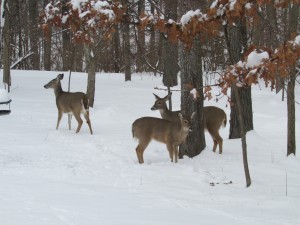
Deer prefer to bed down on a south facing slope to protect them from fierce north winter winds. Photo courtesy Susan Rick.
Deer shed their lighter summer coats of fur for a heavier winter coat that is composed of hollow hair shafts which can absorb and trap heat and a dense underfur. They actually have special skin muscles that allow them to adjust the angle of the hair shafts to provide the best insulation. Like the squirrels, the deer prepare for winter by eating more in the autumn to add layers of fat. They may store around 25% of their body weight as fat which is critical to surviving the winter. Their diet focuses on carbohydrate rich food such as nuts, fruit and non-woody perennials.
In the winter the deer’s metabolism slows as does its heart rate, allowing the deer to conserve energy. When times are really tough they reduce their body temperature and heart rate even further to survive. They prefer habitat where they can avoid winter winds and deep snows, favoring south facing slopes which tend to block the north winds, get less snow and have more exposure to sunlight. Deer also have adapted a feeding strategy, balancing energy it takes to find food versus what they get from the food. They eat enough to keep alive, move very little and make it through the winter.
Wild turkeys also adapt as the seasons change. As the days grow short and cold and hard frosts become widespread, the grasses where turkeys forage for insects and seeds die off. Wild turkeys need to consume significantly more food when the temperatures are cold (about 20 grams/day for each decrease in temperature of 10 degrees F). The need for an alternative food source arises and this is when the hunt for nuts begins. We tend to see less and less of them as the search for mast pulls the birds from the roadsides and fields and into the forests. As autumn mast becomes scarce, turkeys survive on mosses, buds, seeds, and fern spores. They will also scavenge man-made food supplies, and these may lure them out into the open at times you would not otherwise see them: for example, feasting on scattered corn left after the harvest, or seeds beneath a birdfeeder. Manure piles are also popular winter feeding sites.
Not only do turkeys’ feeding grounds change as summer fades, so does the company they keep. In the spring and summer, hens and their poults stick together day and night, with flocks often consisting of several hens and their offspring. Once fall sets in, however, the poults are often no longer roosting in the same trees as their mothers. They find nearby trees in which to spend the night. During the day, the poults and hens still feed and travel together. The more significant shift, however, is the departure of the young males, known as jakes, from an established flock. The jakes leave their mothers and sisters and form their own flocks, with siblings often sticking together and joining other young males. Mature toms will also flock with one another in the winter and then separate when the breeding season starts in the spring.
There are reports of seasonal variation in range sizes for bobcats. Some studies show that males have a larger variation in range size than females and can average from 16 square miles to 40 square miles. Other studies show that reproductively active females expand their range size in winter but males merely shift their range to find food. Bobcats can survive for long periods without food but eat heavily when food is abundant. During lean periods it often preys on larger animals, like deer, which it can kill and return to feed on later.
Insects have many strategies to survive winters. They tend to either migrate or they become dormant. Those insects that migrate completely avoid temperatures that pose a threat. Unlike birds, this is not usually a two way event. Due to short life spans of insects, a future generation will usually make the return voyage like the monarch butterfly. The majority become dormant or enter diapause which is similar to mammals that hibernate in the winter. Shorter day length triggers diapause cycles not temperatures. This cold hardiness can be put into two categories, freeze avoidance and freeze tolerance. Freeze tolerant insects can tolerate formation of internal ice and freeze-avoidant insects avoid freezing by keeping bodily fluids liquid. Avoidance involves both physiological and biochemical methods. That may mean burrowing underground or finding shelter in tree trunks or plant stems or under rocks or developing a physical barrier like a wax-coated cuticle that provides protection against external ice. Freeze-avoidant insects also implement strategies to depress the temperature at which their bodily fluids will freeze which is known as supercooling. Farmers are familiar with European corn borer that has a tolerance to cold. The borer larvae can survive being supercooled for several minutes down to -40 degrees F. The bore curls up in corn stalks or corn cobs and is able to survive the winter. Freeze tolerant insects can withstand formation of ice within their tissues. They have developed the ability to manage by controlling where, when and to what extent ice forms. The woolly bear, (Pyrrharctia Isabella), is an example of a freeze tolerant insect.
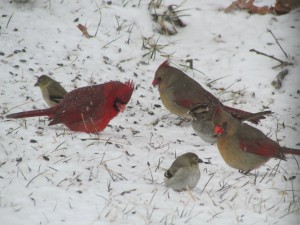
Two gold finches, two northern cardinals (one male, one female) and a sparrow flock together to forage for seeds. Photo courtesy Susan Rick
Birds have likewise developed many strategies to survive the winters. Many bird species migrate either singularly or in flocks to more favorable climates and overwintering feeding grounds. Those that stay will not freeze to death when temperatures drop. They store fat that helps keep them warm during cold days. They fluff their feathers to trap heat and slow their metabolism to conserve energy. Birds also seek good places to roost such as birdhouses, natural tree cavities, evergreens or grass thickets out of the cold extremes. Birds have a protective scale-like covering on their feet and special veins and arteries that keep their feet warm.
If there is sufficient food on their breeding grounds, many birds such as American robins, several finches and owls will remain in the area where they spend the summer. If you choose to feed the birds don’t concern yourself if you leave for a few days. Scientists have shown that chickadees, for example, only get 25% of their daily food from feeders and the other 75% from the wild. They will likely just go to your neighbors and return when you get home. Birds also need a water source in the winter. Don’t worry, they will not bathe in it when the temperature drops below freezing and get their feathers wet.
Maybe those fall chores aren’t so bad after all. We have it pretty good when compared to our feathered and fur bearing friends and the insect world. When the temperature drops we just put on warm clothes, turn the furnace on or make a cozy fire to warm ourselves and raid the cupboard or the refrigerator. Fat storage for us is optional, not required!
CLIFFTOP, a local nonprofit organization, is focused on preserving and protecting area blufflands.
A version of this article appeared in the November 17, 2017, issue of the Monroe County Independent.
© 2017 all content rights reserved Clifftop NFP
Comments are currently closed.

